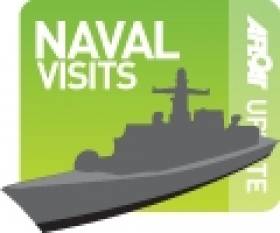Displaying items by tag: Royal Navy frigate
#RoyalFrigate – A Royal Navy frigate is joining in the Belfast Tall Ships Races Festival which has 45 tallships visiting the city including a record 17 of the largest 'A' Class full-rigged vessels, writes Jehan Ashmore.
The Type 23 Duke class frigate HMS Northumberland (F238) is berthed in Pollock Dock and will be open to the public at certain times.
When not tasked on deployments the frigate commissioned in 1994 is based in her homeport of Devon, Cornwall. She along with the impressive A class tallships and those of the B,C and D classes are visiting the city which is also hosting the Belfast Titanic Maritime Festival.
In addition to boarding the 133m frigate of course will be opportuity to step on the decks of the Tallships which are also berthed on the Lagan and close to the Belfast Titanic Quarter. Tallships of all sizes and from many nations are berthed. Among them is the Brazilian Navy's clipper Cisne Branco meaning the 'White Swan'.
Announcements regarding vessel opening times will be notified to visitors over the course of the four –day festival that began yesterday and continues to this Sunday 5 July.
A total of 500,000 visitors are expected to throng the city's quays and the shores of Belfast Lough notably for the festival's maritime spectacle of the Parade of Sail on the Sunday from 11am!
To see the list of all participating tallships, events and much more visit http://tallshipsbelfast.com/
#RugbyRoyal – HMS Portland (F79) a Royal Navy frigate docked in Dublin Port is on for a private-visit and comes in advance of the today's eagerly awaited RBS Six Nations fixture of Ireland versus England, writes Jehan Ashmore.
The Type 23 'Duke' class frigate with 185 crew personal are on shore-leave visit to the capital having arrived on Friday as part of long weekend call.
The rugby venue close to the city centre is the Aviva Stadium which backs onto the banks of the Dodder. This river is a tributary of the Liffey that flows into the port at Ringsend, where downriver is berthed HMS Portland. Also in port is the Naval Service OPV LÉ Aisling (P23), which arrived yesterday and moored alongside the Liffey quays.
Likewise of the Devonport based Royal Naval frigate, the now sole remaining 'Emer' class OPV had also approached Dublin Bay from a northerly direction.
HMS Portland is currently deployed for seven-months as an Atlantic Patrol Ship that is tasked to undertake maritime security operations.
The frigate's arrival to Dublin Bay involved taking a pilot from the cutter Liffey off the Baily Lighthouse. When entering port, sister tugs Beaufort and Shackleton were in attendance.
The 133m frigate is one of the youngest in the Duke-class having been launched on the Clyde in 1999 and commissioned into RN service two year later. They were designed to deal with the Soviet submarine threat.
Among her principle characteristics, she can reach a top speed of 28 knots and has a range of 7,800 nm. As for defence and weapons, they include Seawolf Guided Missiles, Harpoon Long Range Anti-Ship Missiles, MK8 medium range guns and small calibre guns.






























































